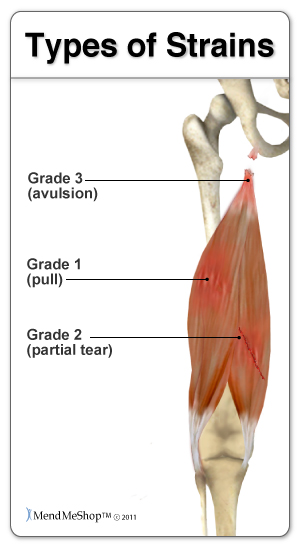There are varying degrees of pulled hamstring muscles. The strain is classified by how severe the damage to the hamstring is.
This is also known as a 'Grade I' tear. A mild strain is classified as the overstretching of the fibers of the muscle or tendon. This type of strain causes discomfort in the upper thigh (and possibly lower back) area as opposed to acute pain. You will generally feel some specific point pain, tightness or mild cramping in your hamstring which will be a little uncomfortable, but will involve no swelling or no major loss of strength. These may diminish with activity, but will may return easily with further activity.

This is also known as a 'Grade II' tear and is an actual tearing of the fibers in the muscle and/or tendon. It would feel like a sharp pain in the back of the leg and you may hear a tearing sound at the time of the injury. There will be a visible hamstring contusion, or bruising, in the torn muscle area in the days following the injury. You will generally experience some pain that radiates down your leg during activity, while bending your knee against resistance, or when you touch your hamstring. Swelling, stiffness, decreased strength and range of motion (may not be able to straighten knee) will be apparent and can also cause you to limp. You may also experience some bruising (ecchymosis) due to bleeding within the injured muscle.
This is also known as a 'Grade III' tear. When a muscle ruptures, or tears completely, you will feel a very sharp pain at the point of the tear and you may hear or feel a 'pop'. A hamstring rupture will involve a complete tear of your hamstring muscle fibers where the muscle belly attaches to the tendon or where you muscle belly rips into 2 separate pieces. This is often very painful and occurs rarely compared to other degrees of strain/tearing. If you have a multi-muscle tear, it normally occurs at the point where your hamstring tendons and muscles meet near the ischium. There will be a significant amount of pain when attempting to move the leg and your range of motion will be limited. There will be a noticeable contusion (hamstring bruising) and swelling. Treatment of a complete tear usually requires surgery to re-join the muscle tissue at the point of the tear.
The majority of hamstring strains are grade 1 or 2 strains that involve partial muscle or tendon tears that occur near the musculotendinous junction, where your hamstring tendon and muscle meet.
This is up to your discretion; however any continued discomfort in your hamstring should be investigated. If you continue to experience the hamstring injury symptoms and have tried the suggested conservative treatments for 2-3 weeks, it is recommended that you seek professional medical attention. It is recommended you seek immediate attention if you:
AidYourHamstring advisors do not work on commission, so be assured you will only receive fair and objective information.
Product Advisors are available 9:00 am to 5:00 pm Eastern Standard Time Monday to Friday.
I want to learn more about Surgery & Post-Surgery Recovery
I want to learn more about Circulation Boost
I want to learn more about Ice & Heat: Which Is Better For Treatment?
I want to learn more about Stretching for the Hamstring
I want to learn more about Soft Tissue Injury Treatments
During your recovery, you will probably have to modify and/or eliminate any activities that cause pain or discomfort at the location of your soft tissue injury until the pain and inflammation settle. The more diligent you are with your treatment and rehabilitation, the faster you will see successful results!
Please be aware that this information is neither intended nor implied to be a substitute for professional medical advice. CALL YOUR HEALTHCARE PROVIDER IMMEDIATELY IF YOU THINK YOU MAY HAVE A MEDICAL EMERGENCY. Always seek the advice of your physician or other qualified health provider before using any of our outstanding products to make sure they are right for you and your condition or if you have any questions regarding a medical condition. Always see your doctor for a proper diagnosis as there are often many injuries and conditions (some very serious) that could be the cause of your pain.
© 2025 In.Genu Design Group, Inc. Contact Us